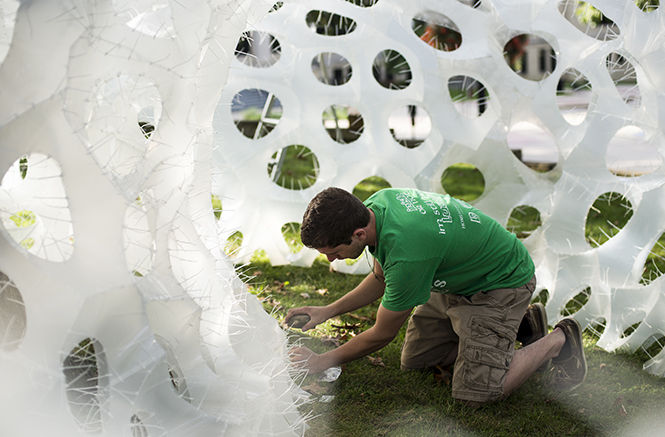KSU architecture students design plastic installation on front campus
Kent State alumnus Adam Hirsh helps to assemble a sculpture on front campus Sunday, Sept 28, 2014, that was designed and created by architecture students as part of the MATr Project. This specific sculpture is compiled of 1,300 panels held together with 40,000 zipties.
September 28, 2014
Underneath a sprawling oak tree outside McGilvery Hall, a white plastic tube enclosed architecture graduate student Cathleen Matuzak.
Matuzak tied together two of the roughly 1,300 plastic panels that support the structure. Her group’s architecture installation is now in its final stages after almost two years in the making.
“It took a lot more time than we expected,” said Matuzak, a graduate architecture student. “No two pieces are alike on this project. It’s all individual (assembly), which is why it has taken so long.”
The installation — nicknamed “the urchin” by the group of graduate students and alumni who created it — is the third structure created in the College of Architecture’s MATr project, a program aimed at helping students demonstrate current digital design methods used in generating forms and building structures.
Matuzak’s group used more than 40,000 plastic ties and 1,300 plastic panels to create the installation, a plastic tube wrapped around an oak tree on front campus. They plan to finish it for Friday’s groundbreaking of the new College of Architecture and Environmental Design across from Franklin Hall.
“I’m happy that every piece came together. Completing this brought us together,” said BoSheng Liu, one of four primary members of the Project MATr team and an architecture graduate student.
The structure, which is 10 feet in diameter and 12 feet at its highest point, follows the curve of the tree branches above it, said Adam Hirsh, a Kent State alumnus who started the project as a graduate student. He said the structure is unique because it was designed for the topography of the location.
“It can’t be any place else besides this specific location,” he said. “The sides of the sculpture follow the tilt of the land.”
Hirsh said he first heard about the MATr project at an all-school meeting in February of 2013.
The MATr project is a series of three architecture installations on campus that demonstrate current digital design methods and digital fabrication. The first project, named “The Passage,” was a yellow wooden tunnel installed over a sidewalk behind Taylor Hall in September 2011. The second, called “The Embrace,” was a triangular metal structure between the MAC Annex and Taylor Hall last year.
Kathryn Strand, the group’s Kent State advisor, selected students to be a part of the project through a preliminary design competition.
Hirsh said once Strand selected the group, they went through a series of workshops with Brandon Clifford, a lecturer at the Massachusetts Institute of Technology, and Wes McGee, associate professor of architecture at the University of Michigan. Both are founders of Matter Design, a digital fabrication firm in Boston. Strand, McGee and Clifford served as advisors on the project.
“It’s not everyday you are able to design and build something like this,” said Alex Smith, one of the primary members of the project and KSU alum. “We talk a lot about building things on the computer, but building it is an important part. That is probably where we learn that most,”
Matuzak said Strand gave the group options for different sites on campus in April 2013 for their installation, which were authorized by University Architect Michael Bruder. The green space on front campus attracted the group to the location in front of McGilvery Hall on Hilltop Drive.
They then generated different digital designs using computer programs Grasshopper, a visual programming language, and Rhinoceros, a 3-D building program.
“The hardest part about the design is that we couldn’t touch the trees in any manner since we are a tree campus,” Hirsh said about the structure’s design. “We wanted to call attention to us being a tree campus but restrain ourselves from affecting the trees.”
Liu said the group created several prototypes before choosing a design that would fit the location.
Smith and Liu went to the University of Michigan in August to use a computer-controlled cutter to make the plastic concave polygons for the installation. The group has spent two months assembling the structure with student and alumni volunteers from the college.
Matuzak said the group had to learn to design, build, purchase material and manage a budget for the design.
“It was a real world experience,” she said. “We definitely bit off a lot more than we could chew. We didn’t realize how big this was, how long this would take and how many zipties and things like that we would use. We definitely underestimated time.”
Hirsh said the group’s countless hours dedicated to the project were worth it.
“We learned so much through mistakes,” he said. “There’s a difference between modeling something in a computer and actually bringing it to reality.”
Contact Madeleine Winer at [email protected].

























